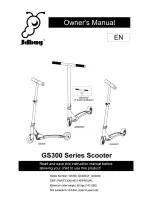
SECURITY
NCM
PARIS MAX 36V
2. SECURITY
2.1 Battery and charger
● Keep the battery and charger away from water and heat sources.
● Do not connect the positive and negative terminals.
● Keep the battery away from children and pets.
● Use the battery and charger only for their intended purpose as part of your e-bike.
● Do not cover the battery or charger, or place objects on it or lean objects against it.
● Do not subject the battery and charger to shocks (eg, dropping).
● Stop charging immediately if you notice anything unusual.
In the unlikely event that the battery catches fire, DO NOT attempt to extinguish it with water. Use sand or other fire retardant instead and call emergency
services immediately.
Avoid contact with the battery and charger during the charging process; the charger heats up considerably.
Please note the additional information on the back of the battery box.
2.2 Use of the bicycle
Try all the bike settings and get used to their different results in a safe and controlled environment before attempting to ride the bike on the road. Pedal
stand bikes may work differently depending on the configuration used.
IMPORTANT SAFETY INFORMATION
1. Always wear a helmet while driving. Make sure your helmet complies with local laws.
2. Keep body parts and other objects away from moving parts of the bicycle that could cause damage, such as wheels and chain. Do not put any object on
the battery or motor. Do not interfere with the transmission in any way.
3. Always wear shoes that will stay on your feet and hold the pedals securely. Never go barefoot or wear sandals.
4. Become familiar with the controls on your bike.
5. Wear bright, conspicuous clothing that is not so loose that you can accidentally get caught in moving parts of the bike or caught by objects on the side of the
road or path.
6. Don't jump on your bike. Jumping with a bike puts incredible stress on most components, such as the spokes and pedals. One of the most vulnerable parts to
jump-related damage is your front fork. Cyclists who insist on jumping on a bicycle risk causing serious damage to the bicycle and themselves.
7. Consider your speed and keep it at a level that is consistent with the conditions. Always keep in mind that there is a direct relationship between speed
and control, and also between speed and component stress.
8. Always follow local traffic laws.
9. Never drive under the influence of alcohol or drugs.
10. If you have any health conditions, consult your doctor before riding your bicycle.
11. Never put yourself or others in danger as a result of reckless driving.
12. Be aware that stopping distance increases with imperfect road conditions such as gravel or wet surfaces.
13. Check the brake cable routing before riding your bike. Make sure both brakes are working and in good condition.
14. The e-bike is especially suitable for riding on trails and paved roads. It is recommended not to use the e-bike for extreme mountain rides with multiple
slopes, as the system is not designed for these slopes due to the torque of the engine.
04







































